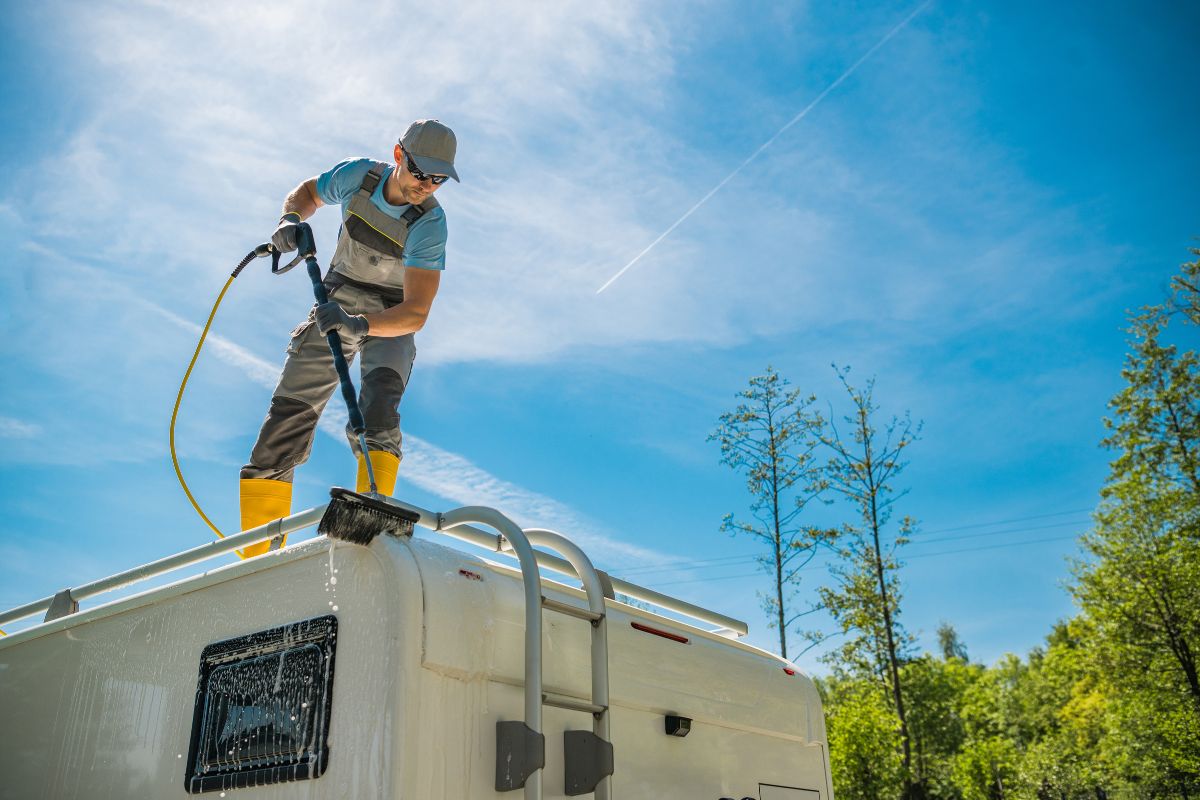Discover How To Use The Power of Authority Marketing To Make You Money While You Adventure!
No Experience, Existing Product Or Technical Skills Are Required
DO YOU BELIEVE ADVENTURES ARE WORTH CHASING?
We're an affiliate.
We hope you love the products/services we recommend on Just Van Life! So you know, there is the possibility we will collect a commission should you make a purchase via any of our links. This will in no way affect the purchase price. Thank you for your support, we really appreciate it!
The majority of RVs are made from fiberglass which is a lightweight and inexpensive material. While this is good news for RV owners it does come with its own maintenance issues such as oxidation.
We have looked and how to remove oxidation from fiberglass RVs to help you with this problem.
Explaining Oxidation On An RV
Oxidation occurs when a surface comes into contact with oxygen or other substances which cause the loss of electrons. This typically happens with metal which results in rust and corrosion. But it can happen in lots of materials and fiberglass is one of them.
The protective gel coating on the surface of fiberglass RVs is constantly exposed to the elements particularly the sun which accelerates the process of oxidation. The frequently changing conditions that your RV is subjected to can damage this protective coating.
On a fiberglass surface such as on an RV, oxidation is the loss of the shine and the dulling of the surface combined with a chalky appearance.
How To Remove Oxidation From Fiberglass
When this happens to your fiberglass RV what can you do to remove the oxidation from the surface? There are a few methods and the one you choose will depend on the extent of the oxidation on the vehicle.
Hand buffing is exactly what it says, polishing the oxidized surface by hand. Using a power buffer means less physical effort on your part and less time to restore the RV to a shine. Restoring an RV with extreme oxidation will require more extensive work.
Hand Buffing To Remove Oxidation
If the oxidation is not too bad you can hand buff the surface to restore the shine. You’ll need some elbow grease, polishing compound and a non-abrasive sponge. Apply the polish and work it into the surface of the RV.
Continue polishing until you no longer feel any resistance. Now you can let the polish dry to a light haze. Using a clean, dry cloth wipe off the haze, and you will have a shiny surface underneath.
You can top this off with an RV grade or marine wax. This should be applied with a clean cloth, allowed to dry to a haze and polished off until the surface is shiny.
Using A Power Buffer To Remove Oxidation
If that all sounds like a bit too much hard work you can use a power buffer to remove the oxidation from your RV. This method works well on large vehicles where you have a lot of surface area to cover. For nooks and crannies use the hand method as above.
You can use the power buffer to apply the polish to the surface as well as to remove the oxidation. It can also be used to apply the wax once you are ready to apply that and buff it to a high shine. The wax protects the fiberglass surface of the RV.
Restoring An RV With Extreme Oxidation
Sometimes the oxidation on the surface of an RV is so advanced that even quality polishes can’t remove it. In these cases it is necessary to use the wet sanding method. However this is a time consuming process and should be done by professionals.
It involves soaking sandpaper from 600 to 2,000 grit for 24 hours. The sandpaper is placed on a foam block and used to sand the fiberglass surface until it is smooth to the touch. Sanding is followed by with high grade polish which may need multiple coats.
On some RVs with extreme oxidation you may find strands of fiberglass coming loose. If this happens your RV has erosion. You can either have a professional paint job done or get the fiberglass gel coated again. Gel coating will however, last longer than a paint job.
Using Vinegar To Remove Oxidation From RV
It is possible to use vinegar to remove oxidation from an RV, although you will only be able to use it for light oxidation. Heavy or extreme oxidation will not respond to the use of vinegar, and you will have to use one of the methods described above.
Vinegar will not protect the fiberglass surface of the RV, and it would need to be used in conjunction with a good quality wax.
How To Restore Yellowed RV Fiberglass

If you are purchasing an older RV or yours has become yellowed then you may wonder if it’s possible to restore it to a brilliant white. Catching the yellowing in time may help to reverse it before it goes too deep into the fiberglass surface.
To test this use a wet sandpaper of 800 to 400 grit to sand down the gel coat in a hidden area. As you sand you should see the white color coming through. If you don’t then the yellowing has gone too far to be restored.
When the white can be seen underneath you will have to sand the surface using finer sandpaper at each stage. To get the gloss back use a cutting compound and finish off with a high quality wax.
Washing Tips To Prevent Oxidation On RVs
One of the best ways to prevent oxidation on your RV is to regularly use a specific wash and wax product on the vehicle. This will keep the grime and dirt from building up and will also impair oxidation.
You should also wax your RV at least once a year to maintain its shine and provide a protective coating.
Maintenance Of Fiberglass RVs
Forward planning can help with maintaining your fiberglass RV. when you are not using it keep the vehicle out of the sun under a canopy or cover. Avoid parking it under a tree as the sap and bird droppings will certainly cause surface damage.
Regular washing and waxing will also protect the gel coating when the RV is in use and exposed to the elements.
Final Thoughts
We hope that you have found this guide to removing RV oxidation helpful and informative.
Discover How To Use The Power of Authority Marketing To Make You Money While You Adventure!
No Experience, Existing Product Or Technical Skills Are Required
DO YOU BELIEVE ADVENTURES ARE WORTH CHASING?
